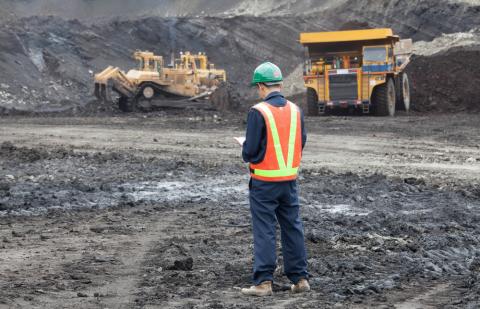Media Monitor: U.S. Coal, Battered and Baffled, ‘Is on the Way Out’
Stark is the word to sum up Lester R. Brown’s assessment of the health of the U.S. coal industry.
“The coal companies—the big ones—have really sort of bit the dust in terms of stock prices, in terms of sales,” Brown said yesterday in a nationally syndicated radio segment of WNYC’s Leonard Lopate Show (“The Large-Scale Shift to Renewable Energy”).
“Nobody wants to buy coal stocks. Coal is on the way out.”
Brown’s remarks are informed by a lifetime of energy-industry study. Granted, as founder of the Earth Policy Institute and the World Watch Institute, he brings a certain agenda to the discussion. He’s also promoting a new book, “The Great Transition: Shifting from Fossil Fuels to Solar and Wind Energy,” written with Janet Larsen, director of the Earth Policy Institute.
Yet both Brown and Larsen, who was also on the Lopate show, are well rooted in reality.
Here’s Larsen on Peabody Energy, the granddaddy of all coal companies: “Between late 2006 and 2014 their market value fell 61 percent. They were removed from the S&P 500 because of their poor performance. With coal, the writing’s on the wall.”
Persuasive factoids presented by Brown and Larsen:
- Solar-energy use has grown by 60 percent annually over the past five years, its cost has fallen from $4 per watt in 1990 to 70 cents today and some solar companies see it dropping to 40 cents per watt.
- China gets more of electricity now from wind farms than nuclear power plants, “and this has happened almost overnight,” while the growth of coal-fired generation has slowed—“a political problem at the local level because of the pollution.”
- The number of coal-fired electricity plants in the U.S. is down from roughly 500 a decade ago to about 370 today, owing greatly to a Sierra Club goal to eradicate U.S. coal-fired generation by 2030—“they’re probably going to make it.”
CORPORATE AMERICA IS INVESTING SO HEAVILY TODAY IN RENEWABLE ENERGY THAT “THE GOOGLES OF THE WORLD are now beginning to get all of their electricity from renewable resources,” Larsen said.
More than 600 companies in the U.S.—including Intel, Staples, and Unilever—get practically all of their power now from renewable sources. Walmart is covering the roofs of 400 of its stores with solar panels.
“This is a business decision. They’re not doing it necessarily to save the world.”
Brown said it only makes sense cost-wise—in the short, the medium and the long term.
“One of the exciting things about shifting to solar and wind is that we never run out. Up until now all the energy sources we’ve been trying to develop whether its oil or coal what have you are finite and they’re exhaustible. Solar and wind are not. How much solar and wind energy we consume has no effect on that which is available tomorrow.”
Meantime, fossil-fuel-industry executives are baffled at how to respond, standing “like a deer in the headlights” as energy markets change.
MUCH OF WHAT BROWN AND LARSEN SAY ECHOES WHAT TOM SANZILLO, IEEFA’s DIRECTOR OF FINANCE, has also argued. Here’s some of what Sanzillo wrote in a commentary posted in December about how Peabody executives have failed badly in dealing with the changing world.
- “Investment analysts were most recently taken aback by Peabody when it offered a bizarre spin on the U.S.-China climate pact announced in November. The company presented the deal as a pro-coal announcement, and the reaction by Wall Street was to drive Peabody stock to record lows while the press reported that CEO Gregory Boyce was seen increasingly as not just a climate-change denier but a man unable to see the energy-market transition taking place right in front of him.”
- “The industry-insider blow to Peabody came from Bob Murray, a fellow rock-ribbed CEO and the head of Murray Energy, who said this fall at a conference sponsored by Platts that those who cannot or will not acknowledge the changes taking place are simply fooling themselves. Murray also dismissed coal-industry rhetoric on the global energy transition as public-relations garbage produced to placate naive investors.”
- “What’s happening is that energy investment is becoming more diversified across the board, criticism of coal where it is still in heavy use is growing, and where it is in little use it is seen as the least-desirable option.”
Yet Peabody executives—and coal-industry executives in general—insist all will somehow be well, and that a magical comeback lies over the horizon.
Karl Cates is IEEFA’s director of media relations.










